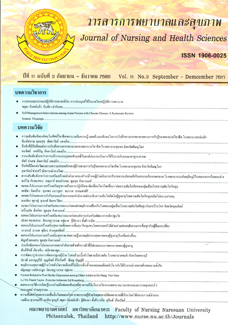The Relationship between the Empowerment of Head Nurses and Safety Management of Nursing Service System in Secondary Care Hospital, the Lower North Region
Main Article Content
Abstract
The purposes of this descriptive research were: (1) to study the empowerment of head nurses in secondary care hospital (2) to investigate the safety management of nursing service system in secondary care hospital (3) to determine the relationship between the empowerment of head nurses and safety management of nursing service system. This study was conducted in secondary care hospital, the lower northen region.One hundred and fifty-five professional nurses working at secondary care hospital, the lower northern region were selected by stratified random sampling technique. Research tools were questionnaires including three parts: (1) demographic data (2) empowerment of head nurses and (3) the safety management of nursing service system. These tools were tested for content validity. The Cronbach’s alpha coefficients of the second and third part were .96 and .96 respectively. Statistical devices used for data analysis were frequency, percentage, mean, standard deviation and Pearson’s product- moment correlation coefficient. The results were as follows; (1) The empowerment of head nurses in secondary care hospital, the lower north region was at a high level. (2) The safety management of nursing service system was at a high level.; (3) there was a statistically significant positive relationship at the high level between the empowerment of head nurses and safety management of nursing service system in secondary care hospital, the lower north region (r = .73, p < .01).
Article Details
References
แนวทางการจัดบริการตามมาตรฐานบริการ
พยาบาลสำหรับ Trauma center. นนทบุรี:
กระทรวงสาธารณสุข.
ทองทรัพย์ ดวงภมร. (2552). ความสัมพันธ์ระหว่าง
การเสริมสร้างพลังอำนาจการทำงานเป็นทีม
กับผลลัพธ์ทางการพยาบาลตามการรับรู้ของ
พยาบาลประจำการโรงพยาบาลศูนย์ เขต 14
กระทรวงสาธารณสุข. วิทยานิพนธ์ พย.ม.,
มหาวิทยาลัยสุโขทัยธรรมาธิราช, นนทบุรี.
นงพงา ปั้นทองพันธ์. (2542). ความสัมพันธ์ระหว่าง
ปัจจัยส่วนบุคคลของพยาบาลประจำการ
ภาวะผู้นำและการเสริมสร้างพลังอำนาจในงาน
ของหัวหน้าหอผู้ป่วย กับความสามารถในการ
ปฏิบัติงานของพยาบาลประจำการหน่วยอภิบาล
ผู้ป่วยหนักโรงพยาบาลของรัฐ. วิทยานิพนธ์
วิทยานิพนธ์ พย.ม., จุฬาลงกรณ์มหาวิทยาลัย,
กรุงเทพฯ.
บุญใจ ศรีสถิตนรากูร. (2553). ระเบียบวิธีการวิจัย
ทางพยาบาลศาสตร์. (พิมพ์ครั้งที่ 3). กรุงเทพ
มหานคร: ยูแอนด์ไอ อินเตอร์ มีเดีย จำกัด.
ประภัสสร นาวเหนียว. (2550). ความสัมพันธ์ระหว่าง
ประสิทธิภาพการบริหารความปลอดภัยใน
ระบบบริการพยาบาลกับความปลอดภัยของ
ผู้ป่วยในโรงพยาบาลชุมชนจังหวัดนครสวรรค์.
วิทยานิพนธ์ วิทยานิพนธ์ พย.ม., มหาวิทยาลัย
สุโขทัยธรรมาธิราช, นนทบุรี.
มยุรัตน์ วิรัชชัย. (2552). ความสัมพันธ์ระหว่างการ
บริหารความปลอดภัยกับคุณภาพชีวิตการ
ทำงานของพยาบาลวิชาชีพโรงพยาบาลรามาธิบดี.
วิทยานิพนธ์ พย.ม., มหาวิทยาลัยสุโขทัย
ธรรมาธิราช, นนทบุรี.
โรงพยาบาลสุโขทัย. (2558ก). ส่วนที่ 1 ข้อมูลทั่วไป
โรงพยาบาลสุโขทัย. รายงานประจำปี 2558
โรงพยาบาลสุโขทัย. สุโขทัย: โรงพยาบาล
สุโขทัย.
โรงพยาบาลสุโขทัย. (2558ข). ส่วนที่ 4.1 กลุ่มภารกิจ
ด้านการพยาบาล. รายงานประจำปี 2558 โรง
พยาบาลสุโขทัย. สุโขทัย: โรงพยาบาล
สุโขทัย.
วิจารณ์ พานิช. (2548). การจัดการความรู้: ฉบับนักปฏิบัติ.
พิมพ์ครั้งที่ 3. กรุงเทพมหานคร: สถาบัน
ส่งเสริมการจัดการความรู้เพื่อสังคม (สคส.).
วีณา จีระแพทย์. (2550) การบริหารความปลอดภัยของ
ผู้ป่วย แนวคิดกระบวนการ และแนวทางปฏิบัติ
ความปลอดภัยทางคลินิก. กรุงเทพมหานคร:
อีเล็ฟแว่นคัลเลอร์.
ศรีสุวรรณ ชูกิจ. (2552) ความสัมพันธ์ระหว่างการ
เสริมสร้างพลังอำนาจทางด้านจิตใจกับผลลัพธ์
ทางการพยาบาลตามการรับรู้ของพยาบาล
วิชาชีพ โรงพยาบาลรามาธิบดี. วิทยานิพนธ์
วิทยานิพนธ์ พย.ม., มหาวิทยาลัยสุโขทัย
ธรรมาธิราช, นนทบุรี.
สรรธวัช อัศวเรืองชัย. (2546). ความปลอดภัยของผู้ป่วย.
จุฬาลงกรณ์เวชสาร. 47, 5 (พ.ค. 2546), 333-350.
สภาการพยาบาล. (2551). แนวทางการส่งเสริมการ
ปฏิบัติการพยาบาลตามจรรยาบรรณวิชาชีพ
(ฉบับปรับปรุง). (พิมพ์ครั้งที่ 3). กรุงเทพฯ: จุดทอง.
อารีย์วรรณ อ่วมตานี. (2550). การเสริมสร้างพลังอำนาจ
ในระบบการบริหารพยาบาล ในประมวลสาระ
ชุดวิชาการพัฒนาศักยภาพระบบการบริหาร
การการพยาบาล. หน่วยที่ 14 หน้า 1-47.
นนทบุรี: มหาวิทยาลัยสุโขทัยธรรมาธิราช.
Bandura, A. (1986). Social foundations of thought and
action: A social cognitive theory. New Jersey:
Prentice-Hill.
Benner, P. (1984). From Novice to Expert. Menlo-
Park CA: Addison-Wesley.
Elizer D. Borg, I, Hunt, R, & Beck, I. M. (1991).
The structure of work values: across cultural
comparison. Journal of Organization Behavior.
12(1), 21-38.
Thomas, K. W. & Velthos, B. A. (1990). Cognitive
element of empowerment. Journal of nursing
administration. 23(1), 18-23.


